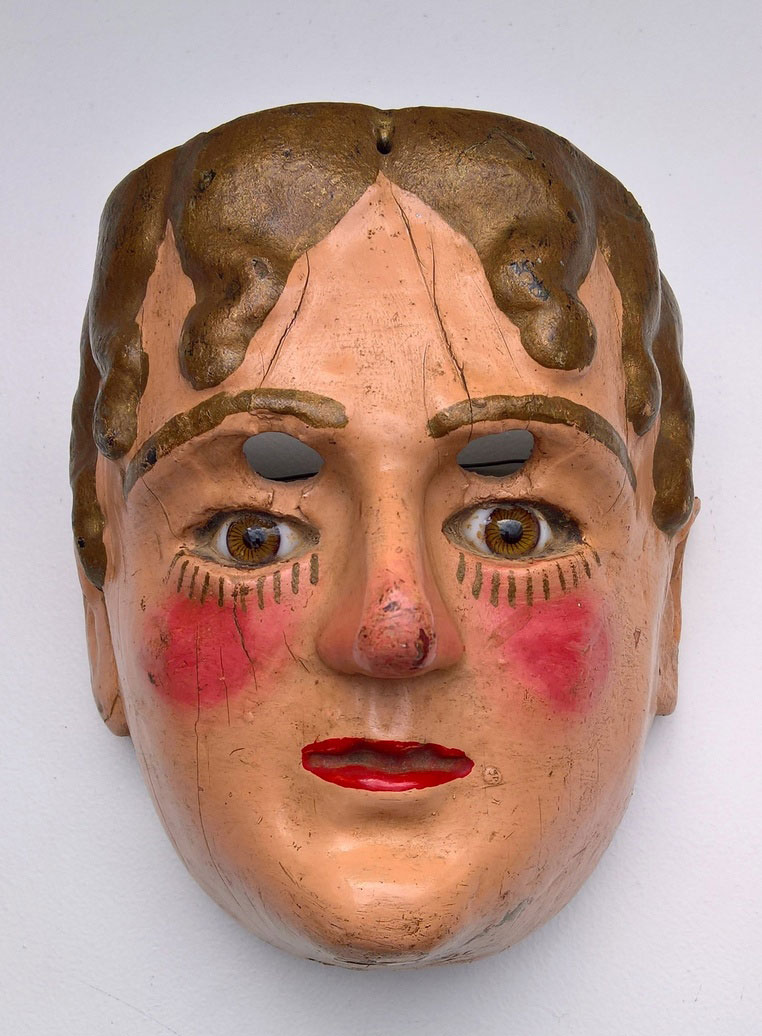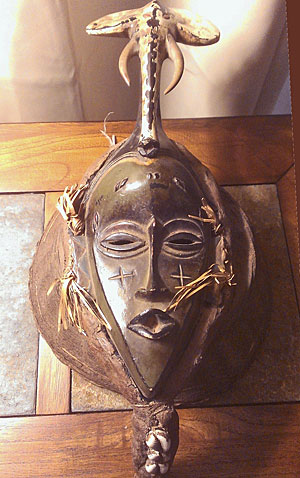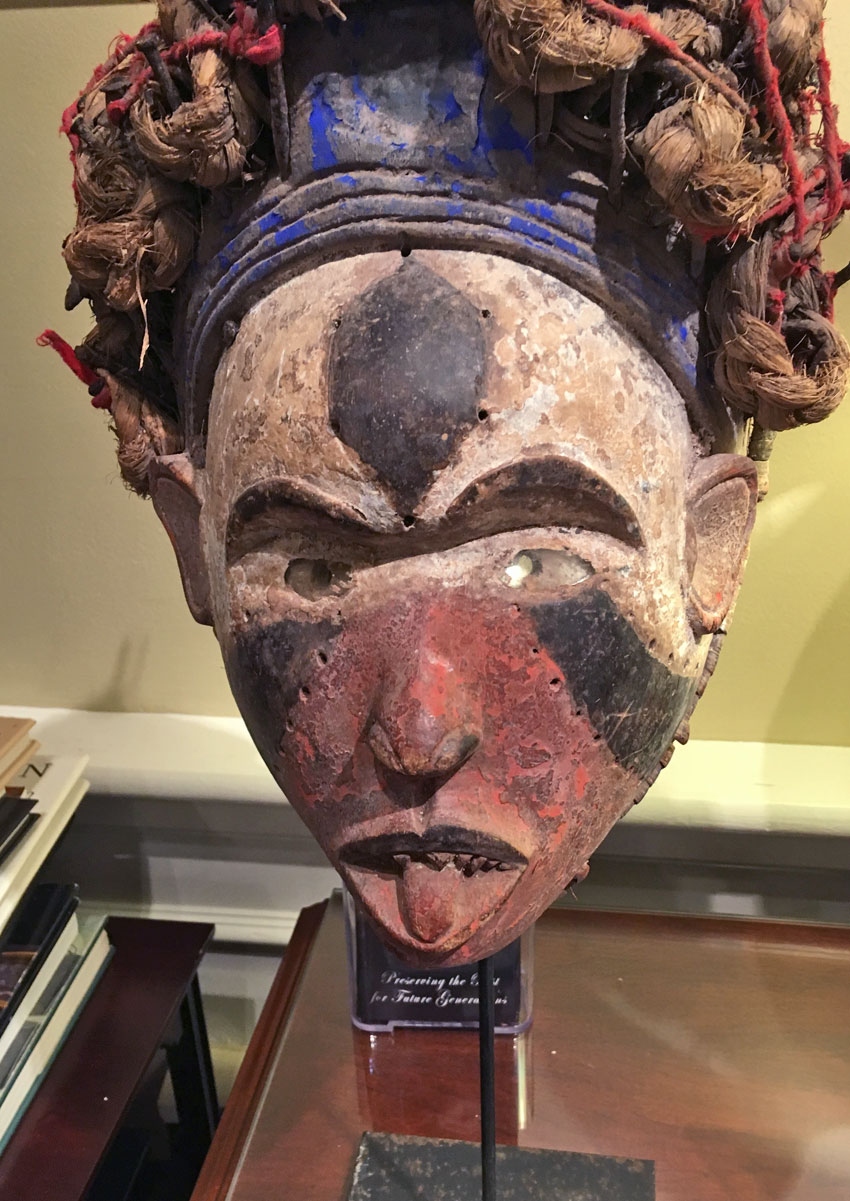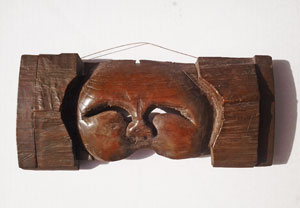 Q: Here is a small mask (6” height) of a “Cristiano”, with interesting moreria burns on the back. On the right side we see “ɛT”, the mark of Eugenio Tistoj (1855-1930), owner of the well-known moreria in Totonicapán, and on the left side a combination of “ATP”, the mark of Pedro Antonio Tistoj (1912-1978), son of Eugenio Tistoj, owner of the moreria after his father. These marks, together with the beautiful patina, allow to date the mask from the very early XXth century. As Jim Pieper reports in his book “Guatemala’s masks and dramas”, there are presently 2 morerias in Totonicapàn with the name Tistoj, both descendants of Eugenio Tistoj, their great grandfather. It is not that usual to see such interesting old burnings on a mask nowadays. Jean, 1468
Q: Here is a small mask (6” height) of a “Cristiano”, with interesting moreria burns on the back. On the right side we see “ɛT”, the mark of Eugenio Tistoj (1855-1930), owner of the well-known moreria in Totonicapán, and on the left side a combination of “ATP”, the mark of Pedro Antonio Tistoj (1912-1978), son of Eugenio Tistoj, owner of the moreria after his father. These marks, together with the beautiful patina, allow to date the mask from the very early XXth century. As Jim Pieper reports in his book “Guatemala’s masks and dramas”, there are presently 2 morerias in Totonicapàn with the name Tistoj, both descendants of Eugenio Tistoj, their great grandfather. It is not that usual to see such interesting old burnings on a mask nowadays. Jean, 1468
A: It’s nice that Jean was willing to share this mask with us. He knows a lot about Guatemala. All I want to add is the importance of the moreria mark on the rear. Morerias are the small shops that make lots of masks and costumes and rent them to the villagers for participation in the local festivities. These shops are always making a few new masks and costumes. Older masks occasionally get repainted to save time and money. Costumes get patched. Everywhere else in the world masks and costumes are made at home or purchased from craftsmen. I like the concept of morerias. Why do other cultures not have something similar?
Today most masks are made for tourists and exporters. Some of them look traditional, but most are not acceptable for collecting. This one certainly is! A








4 Comments
Jean
Although considered here as a “Cristiano” used in the Baile Moros y Cristianos, this mask could also be a female character, as the “Princesa” in the Baile della Conquista de Guatemala. It is indeed very similar to several others presented in Joel E Brown’s books. As he explains in his books, these female masks are usually called “Malinche”, especially by less expert dealers or publications, although they rarely represent Cortes’ indian wife, but other female characters depending on the specific dance.
Jean Van de Stadt
I visit last week the Tistoj moreria in Totonicapán, and had the occasion to discuss with Jose Alejandro Tistoj, the present owner of this moreria: he confirm to me that this mask was intended to be a “Cristiano” as initially presented, not a female mask as suggested by me in the comment above.
Jean
Last week, I visit the Tistoj moreria in Totonicapán, and gathered several pieces of information in discussion with the present owner.
He confirmed to me that this mask was well intended to be a “Cristiano” when carved by his great-grandfather, as I indicated initially. Thus not a female character.
Bruce Sondern
This was helpful ty.
Does anyone know the mask maker that goes by C J ?
I have several. They are very well carved and of great proportion, signed of course and appear very old. Old is relative I understand. But I collect 18th c. furniture so I familiar with old wood items.
Does anyone have any understanding of age here and more importantly value.
You are welcome to email or start a dialogue .
The pieces I have came to me via the Catholic Church in Guatemala. The church sold from it’s own collections after the 1976 Earthquake and subsequent floods. They did this to raise money for those in need. All these pieces were very handsome. Most masks were signed. I’ve rarely seen this then or now.
I collected through high school and college and this caliber was already impossible to find even then, 50 yeas ago. They definitely are not to be confused with the tourist trade masks of the 60’s and 70’s. These were old even then.
Thanks, Bruce